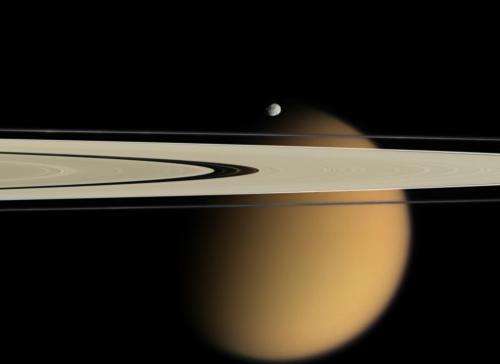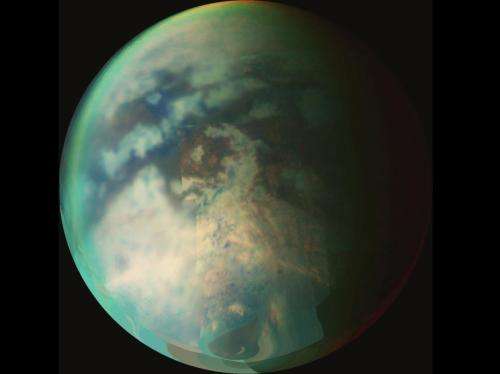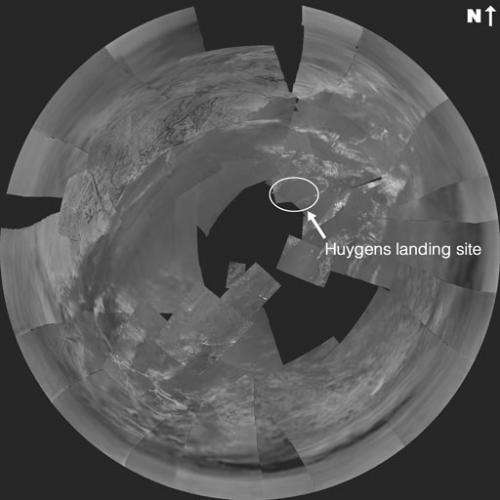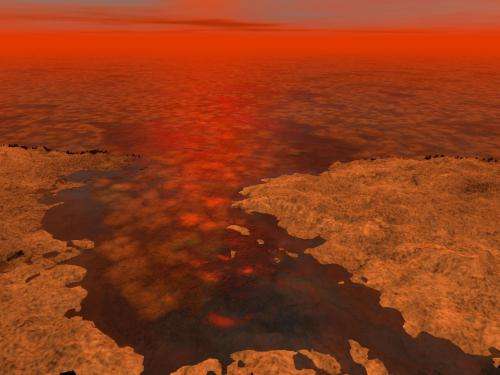Titan offers clues to atmospheres of hazy planets

When hazy planets pass across the face of their star, a curious thing happens. Astronomers are not able to see any changes in the range of light coming from the star and planet system.
This presents a puzzling problem for scientists trying to find out what is inside planetary atmospheres. Usually, astronomers can look at a star before and after a large planet goes across, note the difference in the spectrum, and make predictions about what elements are contained in the planet's atmosphere. If the atmosphere contains elements consistent with water or ozone, for example, this could be a sign of life.
"It seems to indicate there is something in their atmosphere that is blocking our ability to see the gas in the atmosphere," said Tyler Robinson, a postdoctoral fellow at the NASA Ames Research Center.
"So along with my coauthors, we realized that we have a perfect example of a hazy world right here in the Solar System —Titan. And we wondered what Titan would look like if you saw it transiting across a star," said Robinson.
The work was published in the Proceedings of the National Academy of Science in May and is also available in preprint version on the website Arxiv.
Harnessing creativity
NASA has never launched a probe designed to go out in the Solar System and watch our own planets and moons transiting across the sun. Luckily for the researchers, there was a way to simulate this with the Cassini mission, which is in orbit around Saturn and its moons, which include Titan.
Titan is of particular interest to researchers because its hydrocarbon cycle reminds some biologists of what Earth would have looked like before life. Titan has other features that are similar to Earth as well, such as weather patterns and a liquid cycle in which methane and ethane go between lakes in the ground to clouds in the air and back again.
Titan was first spotted up close in the 1980s when NASA's spacecraft Voyager flew by Saturn. Saturn's largest moon fascinated scientists because it was shrouded in orange haze. The haze likely comes from complex organic materials that are produced when ultraviolet light from the Sun shines on the atmosphere, which is made up of nitrogen and methane. This was unexpected, as many had thought that Earth's airless moon was typical of other moons in the Solar System.
Cassini arrived at Saturn in 2004 and released an atmospheric probe, Huygens, which made it to the surface of Titan and survived for a short while. Cassini is now entering its eleventh year of operations, which includes more than a hundred flybys of Titan. For many of these flybys, the scientists measured how the Sun appears through the moon's atmosphere, doing what are known as occultation measurements.
"When it does these flybys it does occultation measurements, measuring sunsets and sunrises through Titan's atmosphere," Robinson said.

It records data in light waves ranging from 800 nanometers (visible light) to five microns (infrared, or the signature emitted by heat.) These sunset and sunrise measurements normally are used to see how Titan's atmosphere is transparent to sunlight at different heights, which can be used to detect a variety of gases in the atmosphere, Robinson said. To better understand Titan in the context of a hazy exoplanet, Robinson and his colleagues approached the data from a new perspective, projecting how a distant Titan would appear if it was going across the face of the Sun.
Exoplanet differences
The procedure involves combining all the information from different altitudes into a single "transit" spectrum that would represent how Titan would look from a distance, said Robinson. Also, the scientists had to change the measurements somewhat to represent seeing an entire atmosphere backlit by a star, rather than the current measurements that looked at the Sun through a small portion of Titan's atmosphere.
Results indicated a few interesting findings. Methane was detected on the moon, which is considered a "biosignature," or indication of life, because it can be emitted by microbes and other lifeforms. The gas is not a sure thing for lifeforms, however, as it also can be emitted through processes in a planet's crust, for example.
"The haze also has some interesting effects on the spectrum," Robinson said.
Specifically, it blocks out blue light better than red light, which makes it look redder when it passes across the Sun. This finding indicates that Titan's haze is dissimilar to that of hazy exoplanets, he said, because the transit spectrum for the exoplanets shows no change with color.
"It sheds some light on what the composition of the hazes might be for these exoplanets," Robinson added. "Some people thought they are similar to Titan's haze, and this rules that out because the spectra are not similar to one another."
One encouraging aspect of the study was the accuracy of the view from orbit. With Cassini, the researchers saw similar haze abundances in the atmosphere as the Huygens probe did. This means that it is possible to get the same accuracy for haze predictions as it would be to send a probe into the atmosphere, Robinson said. Moreover, those abundances remained fairly stable over time, which is important because the haze observations spanned eight Earth years of collection.
"It's interesting. Those haze properties agree really well with the same properties that were measured by the Huygens probe which flew down through the atmosphere. Huygens gave a lot more information, but this is an example of where they overlap with the data," Robinson said.

But they have seen some seasonal changes. Cassini has followed Titan through almost half of a Saturnian year, and is now watching the system swing towards summer.
"As the wind patterns slowly change on Titan, you get different haze distributions and different haze thicknesses in different locations in the planet," Robinson said.
Building a spectrum of Earth
So how do we find out what those exoplanets are made of? Robinson suggests the solution may lie in better resolution. NASA's James Webb Space Telescope, when it launches in 2018, will be better able to spot the so-called "absorption" features that hazy exoplanets exhibit when they pass across stars.
It's very hard to predict what elements could be present in super-Earths or mini-Neptunes, which are planets that are somewhat larger than Earth but not as big as a gas giant like Jupiter. This is because there are elements in the interior that could be affecting what is seen in the atmosphere, Robinson said.

The same problem isn't present in "hot Jupiters"—the large planets that orbit close to their parent stars. Astronomers are fairly confident they have helium and hydrogen, because these planets have similar composition to stars. They just aren't big enough to kickstart nuclear fusion.
Robinson's team was the first to transform a sunset spectrum into predictions for exoplanet transits, and it's a technique that he is hoping to reuse for other locations in the Solar System. A prime example would be to do a "realistic" transit spectrum of our own planet Earth. There was an instrument aboard the International Space Station called the Atmospheric Trace Molecule Spectroscopy (ATMOS) that could do just that, he said.
More broadly, Robinson said he is interested in looking at those missions in the Solar System where scientists have "ground truth" (information obtained from a landing craft) about processes happening on a planet's surface that could affect what's happening in the atmosphere.
More information: Tyler D. Robinson, Luca Maltagliati, Mark S. Marley, and Jonathan J. Fortney. "Titan solar occultation observations reveal transit spectra of a hazy world." PNAS 2014 ; published ahead of print May 29, 2014, DOI: 10.1073/pnas.1403473111
"Titan solar occultation observations reveal transit spectra of a hazy world." Tyler D. Robinson, Luca Maltagliati, Mark S. Marley, Jonathan J. Fortney. arXiv:1406.3314 [astro-ph.EP]DOI: 10.1073/pnas.1403473111
Journal information: Proceedings of the National Academy of Sciences , arXiv
Provided by Astrobio.net
This story is republished courtesy of NASA's Astrobiology Magazine. Explore the Earth and beyond at www.astrobio.net .



















